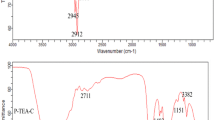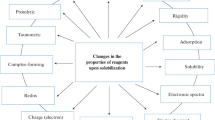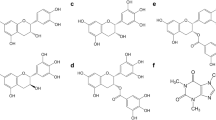Abstract
Microemulsion electrokinetic chromatography (MEEKC) is a powerful tool to separate neutral species based on differences in their hydrophobic and hydrophilic properties. However, as a major drawback the conventionally used SDS based microemulsions are not compatible with electrospray ionization mass spectrometry (ESI-MS). In this work, a surfactant-free microemulsion (SFME) consisting of water, ethanol, and 1-octanol is used for surfactant-free microemulsion electrokinetic chromatography (SF-MEEKC). Ammonium acetate was added to the SFME enabling electrophoretic separations. The stability of SFMEs containing ammonium acetate was investigated using small-angle X-ray scattering and dynamic light scattering. A method for the separation of a model system of hydrophobic and hydrophilic neutral vitamins, namely the vitamins B2 and D3, and the cationic vitamin B1 was developed using UV/VIS detection. The influence of the ammonium acetate concentration on the separation performance was studied in detail. The method was characterized concerning reproducibility of migration times and peak areas and concerning the linearity of the calibration data. Furthermore, SF-MEEKC was coupled to ESI-MS investigating the compatibility between SFMEs and the ESI process. The signal intensities of ESI-MS measurements of the model analytes were comparable for SFMEs and aqueous systems. Finally, the vitamin D3 content of a drug treating vitamin D3 deficiency was determined by SF-MEEKC coupled to ESI-MS using 25-hydroxycholecalciferol as an internal standard.

The concept of surfactant-free microemulsion electrokinetic chromatography coupled to electrospray ionization mass spectrometry





Similar content being viewed by others
References
Terabe S, Otsuka K, Ichikawa K, Tsuchiya A, Ando T. Electrokinetic separations with micellar solutions and open-tubular capillaries. Anal Chem. 1984;56:111–3.
Altria KD, Mahuzier PE, Clark BJ. Background and operating parameters in microemulsion electrokinetic chromatography. Electrophoresis. 2003;24(3):315–24.
Pyell U, ed. Electrokinetic chromatography: theory, instrumentation and applications. John Wiley & Sons; 2006.
Tripodi V, Flor S, Carlucci A, Lucangioli S. Simultaneous determination of natural and synthetic estrogens by EKC using a novel microemulsion. Electrophoresis. 2006;27:4431–8.
Vomastova L, Mikšik I, Deyl Z. Microemulsion and micellar electrokinetic chromatography of steroids. J Chromatogr B Biomed Sci Appl. 1996;681:107–13.
Mahuzier PE, Altria KD, Clark BJ. Selective and quantitative analysis of 4-hydroxybenzoate preservatives by microemulsion electrokinetic chromatography. J Chromatogr A. 2001;924(1–2):465–70.
Huang HY, Lai YC, Chiu CW, Yeh JM. Comparing micellar electrokinetic chromatography and microemulsion electrokinetic chromatography for the analysis of preservatives in pharmaceutical and cosmetic products. J Chromatogr A. 2003;993(1–2):153–64.
Hsi-Ya H, Chia-Ling C, Chen-Wen C, Jui-Ming Y. Application of microemulsion electrokinetic chromatography for the detection of preservatives in foods. Food Chem. 2005;89(2):315–22.
Xie JP, Zhang JY, Liu HX, et al. Microemulsion electrokinetic chromatography with laser-induced fluorescence detection: as tested with amino acid derivatives. Biomed Chromatogr. 2004;18(8):600–7.
Javor T, Buchberger W, Tanzcos I. Determination of low-molecular-mass phenolic and non-phenolic lignin degradation compounds in wood digestion solutions by capillary electrophoresis. Microchim Acta. 2000;135(1–2):45–53.
Terabe S, Matsubara N, Ishihama Y, Okada Y. Microemulsion electrokinetic chromatography: comparison with micellar electrokinetic chromatography. J Chromatogr A. 1992;608(1–2):23–9.
Subirats X, Yuan HP, Chaves V, Marzal N, Roses M. Micoemulsion electrokinetic chromatography as a suitable tool for lipophilicity determination of acidic, neutral, and basic compounds. Electrophoresis 2016;37(14):2010–2016.
Zemann AJ. Conductivity detection in capillary electrophoresis. Trends Anal Chem. 2001;20(6–7):346–54.
Gennaro LA, Salas-Solano O, Ma S. Capillary electrophoresis-mass spectrometry as a characterization tool for therapeutic proteins. Anal Biochem. 2006;355(2):249–58.
Olivares JA, Nguyen NT, Yonker CR, Smith RD. On-line mass spectrometric detection for capillary zone electrophoresis. Anal Chem. 1987;59(9):1230–2.
Yu LS, Xu XQ, Huang L, Ling JM, Chen GN. Separation and determination of flavonoids using microemulsion EKC with electrochemical detection. Electrophoresis. 2008;29(3):726–33.
Bytzek AK, Reithofer MR, Galanski M, Groessl M, Keppler BK, Hartinger CG. The first example of MEEKC-ICP-MS coupling and its application for the analysis of anticancer platinum complexes. Electrophoresis. 2010;31(7):1144–50.
Hoffmann E, Stroobant V. Mass spectrometry. Principles and applications. John Wiley & Sons; 2007.
Matysik F-M, Neusüss C, Pelzing M. Fast capillary electrophoresis coupled with time-of-flight mass spectrometry under separation conditions of high electrical field strengths. Analyst. 2008;133(12):1764–6.
Klossek ML, Touraud D, Zemb T, Kunz W. Structure and solubility in surfactant-free microemulsions. ChemPhysChem. 2012;13(18):4116–9.
Smith GD, Donelan CE, Barden RE. Oil-continuous microemulsions composed of hexane, water, and 2-propanol. J Colloid Interface Sci. 1977;60(3):488–96.
Diat O, Klossek ML, Touraud D, et al. Octanol-rich and water-rich domains in dynamic equilibrium in the pre-ouzo region of ternary systems containing a hydrotrope. J Appl Crystallogr. 2013;46(6):1665–9.
Marcus J, Touraud D, Prévost S, Diat O, Zemb T, Kunz W. Influence of additives on the structure of surfactant-free microemulsions. Phys Chem Chem Phys. 2015;17(48):32528–38.
Vitale SA, Katz JL. Liquid droplet dispersions formed by homogeneous liquid - liquid nucleation: “the ouzo effect”. Langmuir. 2003;19:4105–10.
Schöttl S, Marcus J, Diat O, et al. Emergence of surfactant-free micelles from ternary solutions. Chem Sci. 2014;5(8):2909–3340.
Zemb T, Klossek ML, Lopian T, et al. How to explain the occurrence of microemulsions formed by solvent mixtures without surfactants. Proc Natl Acad Sci U S A. 2015;113(16):4260–5.
Fischer V, Marcus J, Touraud D, Diat O, Kunz W. Toward surfactant-free and water-free microemulsions. J Colloid Interface Sci. 2015;453:186–93.
Hankel RF, Rojas PE, Cano-Sarabia M, et al. Surfactant-free CO2 -based microemulsion-like systems. Chem Commun. 2014;50(60):8215–8.
Zoumpanioti M, Karali M, Xenakis A, Stamatis H. Lipase biocatalytic processes in surfactant free microemulsion-like ternary systems and related organogels. Enzym Microb Technol. 2006;39(4):531–9.
Gawrys KL, Blankenship GA, Kilpatrick PK. Solvent entrainment in and flocculation of asphaltenic aggregates probed by small-angle neutron scattering. Langmuir. 2006;22(10):4487–97.
Lopian T, Schöttl S, Prévost S, Pellet-Rostaing S, Horinek D, Kunz W, et al. Morphologies observed in unltraflexible microemulsions with and without the presence of a strong acid. ACS Cent Sci. 2016;2:467–75.
Callmer K, Davies L. Separation and determination of vitamin B1, B2, B6 and nicotinamide in commercial vitamin preparations using high performance cation exchange chromatography. Chromatographia. 1974;7:644–50.
Boso RL, Bellini MS, Miksik I, Deyl Z. Microemulsion electrokinetic chromatography with different organic modifiers: separation of water- and lipid-soluble vitamins. J Chromatogr A. 1995;709(1):11–9.
Altria KD. Background theory and applications of microemulsion electrokinetic chromatography. J Chromatogr A. 2000;892(1–2):171–86.
Acknowledgments
The authors thank Tobias Lopian from the Institut de Chimie Séparative Marcoule (ICSM) for SAXS measurements. S.K. thanks the Fonds der chemischen Industrie (FCI) for a scholarship.
Author information
Authors and Affiliations
Corresponding author
Ethics declarations
Conflict of interest
The authors declare that they have no conflict of interest.
Additional information
Published in the topical collection Fundamental Aspects of Electromigrative Separation Techniques with guest editors Carolin Huhn and Pablo A. Kler.
Andrea Beutner and Sebastian Krickl contributed equally to this work.
Electronic supplementary material
Below is the link to the electronic supplementary material.
ESM 1
(PDF 1.72 mb)
Rights and permissions
About this article
Cite this article
Mohorič, U., Beutner, A., Krickl, S. et al. Surfactant-free microemulsion electrokinetic chromatography (SF-MEEKC) with UV and MS detection - a novel approach for the separation and ESI-MS detection of neutral compounds. Anal Bioanal Chem 408, 8681–8689 (2016). https://doi.org/10.1007/s00216-016-0057-0
Received:
Revised:
Accepted:
Published:
Issue Date:
DOI: https://doi.org/10.1007/s00216-016-0057-0




